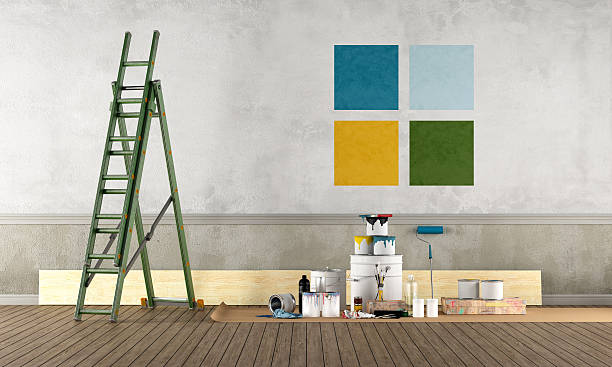Embarking on an interior painting project can be a transformative endeavor, breathing new life into your living spaces. However, the journey from envisioning a freshly painted room to achieving a flawless finish is rife with potential pitfalls. In this comprehensive guide, we delve into the dos and don’ts of interior painting, offering authoritative insights to ensure your project is a resounding success.
Do: Invest in Quality Tools and Materials
The foundation of a successful interior painting project lies in the quality of the tools and materials employed. Cutting corners in this department may lead to subpar results and frustration. Invest in high-quality brushes, rollers, painter’s tape, and paints. Quality tools not only make the painting process smoother but also contribute to a professional-looking finish that stands the test of time.
Don’t: Skip Proper Surface Preparation
One of the gravest mistakes in interior painting is neglecting proper surface preparation. Skipping this crucial step can result in paint adhesion issues, uneven finishes, and premature peeling. Take the time to clean surfaces thoroughly, fill any holes or cracks, sand rough areas, and prime surfaces before applying paint. Adequate preparation sets the stage for a flawless and long-lasting paint job.
Do: Test Paint Colors Before Committing
Choosing the right paint color is a pivotal decision that can make or break the aesthetic appeal of your space. Rather than relying solely on paint swatches, take the time to test colors on a small section of the wall. Observing how natural and artificial light interact with the paint throughout the day allows you to make an informed decision, preventing the disappointment of an unfavorable color choice.
Don’t: Neglect the Importance of Primer
Primer is the unsung hero of interior painting. Skipping this preparatory step may lead to uneven color absorption, resulting in a blotchy and inconsistent finish. Whether you’re painting over a dark color, bare drywall, or a glossy surface, applying primer creates a uniform base that enhances paint adhesion and durability. Don’t underestimate the impact of a quality primer on the longevity of your paint job.
Do: Use Painter’s Tape for Clean Lines
Achieving clean and crisp lines between walls, trim, and ceilings requires precision. Painter’s tape is an invaluable tool for creating defined edges and preventing paint bleed. Take the time to apply tape carefully, ensuring it adheres well to surfaces. This simple yet effective technique contributes to a professional-looking outcome that showcases attention to detail.
Don’t: Rush the Drying Process
Impatience is the enemy of a flawless paint job. Rushing the drying process can lead to smudges, smears, and an uneven finish. Allow each coat of paint to dry completely before applying the next. Follow the recommended drying times specified on the paint can, and be mindful of environmental factors such as humidity and temperature, which can influence drying times.
Do: Work in Sections
It can be daunting to tackle a whole room at once, and it could lower the caliber of your job. Rather, break the space up into little areas and concentrate on one at a time. By keeping control over the painting process, this method guarantees even coverage and meticulous attention to detail. It’s also simpler to handle unforeseen difficulties when you work in portions.
Don’t: Overlook Ventilation
Proper ventilation is often underestimated during interior painting projects. The fumes emitted by paint can be harmful, and adequate ventilation is crucial for both your health and the quality of the paint job. Open windows and doors to promote air circulation, and consider using fans to expedite the drying process. If working in a confined space, wear a mask to minimize the inhalation of paint fumes.
Do: Mix Paint Cans for Consistency
Even when purchasing multiple cans of the same paint color, there can be slight variations between batches. To ensure a consistent color throughout the room, mix all the paint cans together before starting the project. This practice, known as “boxing” the paint, eliminates any potential discrepancies in color and creates a seamless and uniform finish.
Don’t: Forget to Protect Your Furniture and Floors
Accidents happen, and splatters and drips are an inherent part of the painting process. Failing to protect your furniture and floors can lead to frustration and unnecessary damage. Cover furniture with plastic sheets or drop cloths and use painter’s tape to secure protective coverings along baseboards. Taking these precautions not only safeguards your belongings but also streamlines the cleanup process.
Do: Pay Attention to Lighting Conditions
The lighting in your home can significantly impact the perception of paint colors. Before finalizing your color choices, consider how natural and artificial light will interact with the paint. Test colors in different lighting conditions to ensure they align with your vision. What looks perfect in daylight may take on a different hue under artificial lighting, and careful consideration prevents unwelcome surprises.
Don’t: Ignore Maintenance and Touch-Ups
Once the paint has dried and your room is transformed, the journey doesn’t end. Regular maintenance and timely touch-ups are essential for preserving the integrity of your paint job. Keep a record of the paint colors used, and store any leftover paint for future touch-ups. Addressing minor imperfections promptly ensures that your freshly painted space retains its pristine appearance for years to come.
Conclusion:
Painting interiors is a kind of art that requires a dedication to excellence and painstaking attention to detail. You give yourself the confidence to handle the painting process by following the dos and don’ts listed in this guide. Transforming your living spaces into a canvas of your vision requires a strategic approach, and with these authoritative insights, you’re well-equipped to achieve a flawless and enduring result.










